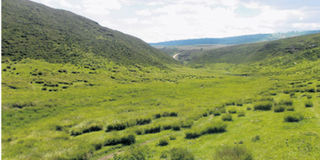Adventure in Mau Narok

Sharpe’s longclaw is found in the tussock grasses
What you need to know:
- The last chance to sight a rare bird.
Being on unfamiliar territory is like opening a new book; every day is an exciting chapter to explore. That is how I feel as I catch the first glimpse of the Mau Narok range, as we branch off the lower escarpment road into Naivasha and along the murram road past the familiar terrain of Hell’s Gate National Park and Elsamere
Hills, vales, and vast panoramas adorn the land; they are unlike anything I have ever seen in Maasai country. It is a patchwork of lilac-coloured flowers in potato fields and copper-rust ears of barley and wheat interspersed with tussock grasslands.
And that is what Dr Luca Borghesio, an associate researcher with the National Museums of Kenya, Dr Muchai Muchane, head of the Zoology Department and their field assistants — James Maina Gichia, John Githogo, and George Nd’ungu — are interested in.
We are looking for Sharpe’s longclaw, an endangered bird, which is found in the tussock grass. I am impressed that we got here aided by a scribbled map drawn by Luca.
Trawling for birds
The map is not to scale, but the scribbled blocks represent layers of plateaus. The oblong patch is the stretch of the Mau forest, the block below it is the Mau plateau and a few centimetres from it is the Molo plateau. A few millimetres up is Londiani.
From the map, you cannot fathom the enormity of the area shown until you embark on the journey. We hope to find Sharpe’s longclaw on the high plateaus of Mau Narok, Molo, and Londiani.
This yellow bird with black markings and incredibly long toes for its little frame was first sighted in 1898 in this very plateau by Sir Frederick Jackson, the Lieutenant-Governor of the East Africa Protectorate between 1907 and 1911.
Using Google Earth to identify grasslands, the car halts by a patch of grassland in a valley. The men trawl it, disappearing in the brow, while using a 50-metre wide rope to flush out the birds.
They return disappointed. But when Werner Schroeder from Naturschutzbund Deutschland (the German partner of Nature Kenya) shows a yellow bird he thought was a grassland pipit, the excitement is palpable — it is the Sharpe’s longclaw. The men hike up the hills again and disappear into the horizon.
Mwisho wa Lami
By nightfall, I have lost all sense of direction. Finally, a patch of tarmac appears — a very short stretch with a sprinkling of lights and matatus. I ask a boy what the place is called, he replies “Mwisho”. “Mwisho wa wapi?” I ask while I wait for the men to find us a lodging. “Mwisho ya Lami,” he replies. It is the name of the town. The best hotel in town costs Sh300 for bed and breakfast.
We continue the search the next day, deeper into the grasslands and on to Olokurto. The Maasai town has the most expensive hotel on our itinerary at Sh1,000 per person per night — but we cannot resist the luxury of en suite bathrooms and spacious clean rooms at The Farmer’s Destiny Hotel.
During the State of Emergency in the 1950s, there was a concentration camp at Olokurto, which today is a primary school. Trade in timber thrived and there were numerous sawmills around. “The first power sawmill was opened by a Singh, whose daughters spoke fluent Maa,” recalls Joseph ole Ntaiyia, the manager at the Farmer’s Destiny Hotel.
At a field close to the town, it is probably the last time the men will have an opportunity to look for the Sharpe’s longclaw because the land is marked with beacons for a new shopping complex.




